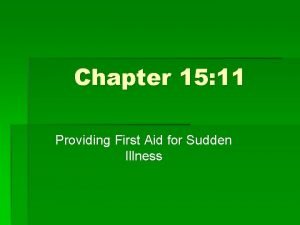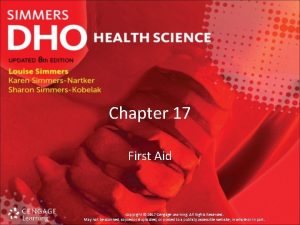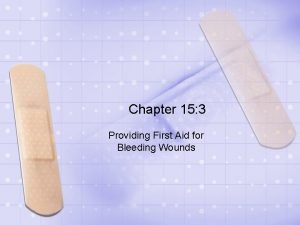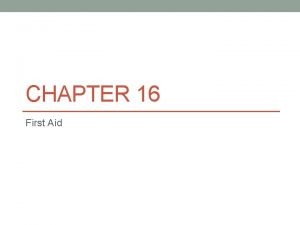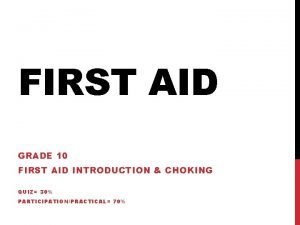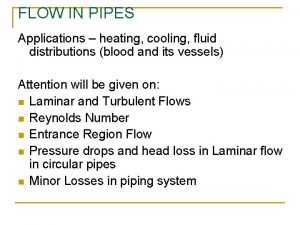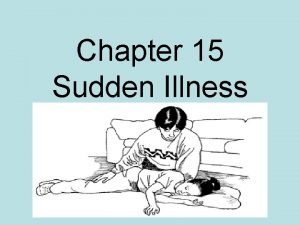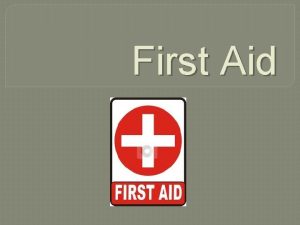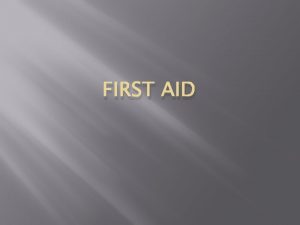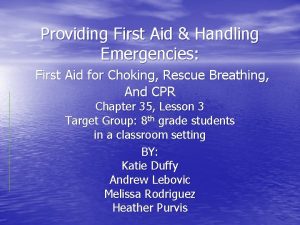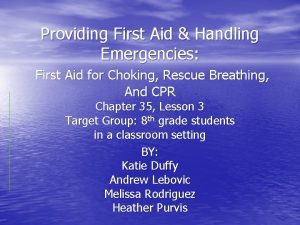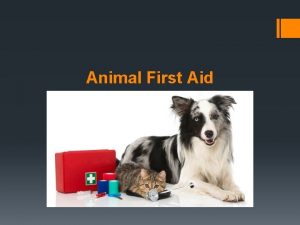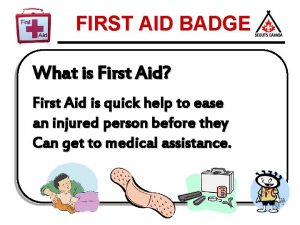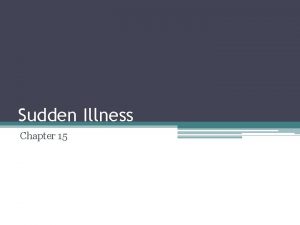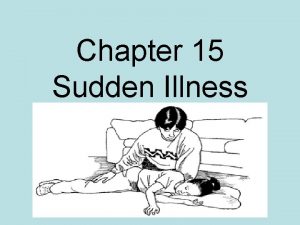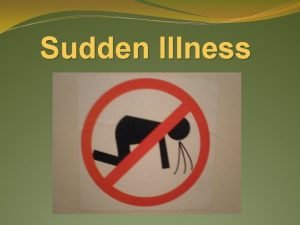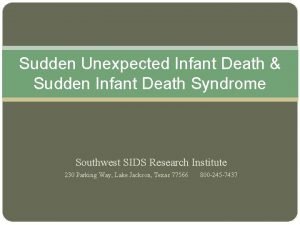Chapter 15 11 Providing First Aid for Sudden



















- Slides: 19

Chapter 15: 11 Providing First Aid for Sudden Illness

Heart Attack § Coronary thrombosis, coronary occlusion, or myocardial infarction. § Occurs when coronary arteries supplying blood to the heart is blocked.

Facts regarding heart attacks § Signs and symptoms: severe, painful pressure under sternum with pain radiating to shoulders, arms, neck and jaw. § Shortness of breath § Skin becomes pale or bluish in color. § Weakness, anxious, apprehensive § Nausea, vomiting, perspiration, loss of consciousness

First Aid for Heart Attack § Have victim lay in comfortable position, relieve pain and assist breathing and obtain medical help.

Cerebrovascular Accident or Stroke § Caused by either presence of clot in a cerebral artery or hemorrhage from a blood vessel in the brain.

Signs and symptoms § Numbness, paralysis, eye pupils unequal in size, mental confusion, slurred speech, nausea, vomiting, difficult breathing and swallowing and loss of consciousness.

Treatment § Maintain respirations, laying victim flat on back with head slightly elevated or on their side. § Obtain medical help immediately. First three hours are crucial to obtaining medicine.

Fainting § Occurs when there is a temporary reduction in supply of blood to brain. § Victim usually regains consciousness after being in a supine position.

Signs and symptoms § Dizziness, extreme pallor, diaphoresis, coldness of skin, nausea, numbness and tingling of hands and feet. § If symptoms are noted, help victim to lie down or sit in a chair and position head at level of knees.

If victim loses consciousness, try to prevent injury. Lie victim down, elevate feet about 12 inches. Use cool water to bathe face. Have victim remain lying down until, regains consciousness and color returns.

Convulsions § Type of seizure, strong, involuntary contraction of muscles. § Occurs in conjunction with: high temperatures, head injuries, bran disease, epilepsy.

Convulsions § Body muscles become rigid, with jerking motions. § Victim may stop breathing, bite tongue, lose bladder and bowel control § Face and lips turn bluish color. § Lose consciousness

Treatment § Remove dangerous objects from area. § Pillow under head, provide respirations if necessary. § DO NOT place anything between victim’s teeth. § DO NOT try to restrain muscle movements.

After convulsion § § § Position victim on side Allow victim to sleep or rest. Obtain medical help

Diabetic Reactions § Diabetes mellitus is a metabolic disorder caused by a lack or insufficient production of insulin. § Victims can go into : Diabetic coma or Insulin Shock

Diabetic coma § Caused by an increase in the level of glucose in bloodstream. § Signs and symptoms: confusion, weakness, dizziness, nausea, vomiting, rapid respirations, sweet or fruity odor to breath. § Medical assistance required ASAP

Insulin Shock § Caused by an excess amount of insulin. Low blood sugar § Signs and symptoms: muscle weakness, confusion, restlessness, diaphoresis, pale, moist skin, hunger pangs, convulsions, loss of consciousness. § Onset of insulin shock can be sudden § Medical attention needed ASAP

Treatment § Give victim drink containing sugar such as orange juice, cube of sugar, hard candy.

Diabetic coma vs. Insulin Shock § Ask questions: Have you eaten today? Have you taken your insulin? § Taken insulin not eaten: Insulin shock § Eaten but no insulin: Diabetic coma § If victim unconscious: place sugar under tongue in case of insulin shock. § Insulin shock much worse than diabetic coma.
 Test chapter 17 first aid
Test chapter 17 first aid Unit 15:11 providing first aid for sudden illness
Unit 15:11 providing first aid for sudden illness Chapter 17:7 providing first aid for heat exposure
Chapter 17:7 providing first aid for heat exposure Chapter 16:3 providing first aid for bleeding and wounds
Chapter 16:3 providing first aid for bleeding and wounds Chapter 16:5 providing first aid for poisoning
Chapter 16:5 providing first aid for poisoning First aid merit badge first aid kit
First aid merit badge first aid kit Unit 15:7 providing first aid for heat exposure
Unit 15:7 providing first aid for heat exposure Objectives of first aid
Objectives of first aid Chapter 8 emergency care first aid and disasters
Chapter 8 emergency care first aid and disasters Chapter 28 first aid and emergencies
Chapter 28 first aid and emergencies Neasden and greenhill medical centre
Neasden and greenhill medical centre Sudden bullets
Sudden bullets Sudden oak death map
Sudden oak death map Inward projecting pipe entrance
Inward projecting pipe entrance Head loss formula for turbulent flow
Head loss formula for turbulent flow Sudden illness examples
Sudden illness examples Water hammer calculation
Water hammer calculation The sudden release of energy stored in rocks causes a(n)
The sudden release of energy stored in rocks causes a(n) Uncontrolled, lacking in restraint
Uncontrolled, lacking in restraint Sudden fiction meaning
Sudden fiction meaning

